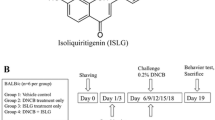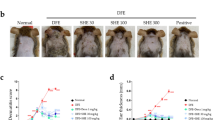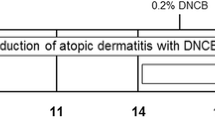Abstract
Atopic dermatitis (AD) is a complex and multifactorial skin disease characterized by skin inflammation and intense pruritus. There are many commercially available treatments such as topical corticosteroids and immunosuppressants to treat of AD, but their effectiveness is limited, and frequent use of these treatments can cause serious side effects. Therefore, the development of new therapeutic agents is necessary for the treatment of AD. Hence, an alternative agent that was derived from natural products that are effective and safe for AD treatment was investigated using experimental models. The biological activity of euscaphic acid has anti-inflammatory, anticoagulant, and antioxidant effects. Despite the various biomedical properties of euscaphic acid, its therapeutic effects on AD have not been well studied. In this study, we investigated the effects of euscaphic acid on skin inflammation and pruritus in AD mouse model. The effects of euscaphic acid were investigated in activated human epidermal keratinocytes and leukemia T lymphoblast cell lines, and Dermatophagoides farina extract and 2,4-dinitrochlorobenzene-induced AD mouse model. Euscaphic acid ameliorated AD properties, such as the expression of inflammatory cytokines and activation of transcription factors. In addition, euscaphic acid reduced critical factors for pruritus such as immunoglobulin E hyperproduction, mast cell invasion, and interleukin-33 expression. Taken together, euscaphic acid could be a potent therapeutic agent for the treatment of AD.




Similar content being viewed by others
Avaiiability of Data and Material
The analyzed data sets presented in this study are available from the corresponding author upon reasonable request.
References
Langan, S.M., A.D. Irvine, and S. Weidinger. 2020. Atopic dermatitis. Lancet 396: 345–360.
Ahn, K., B.E. Kim, J. Kim, and D.Y. Leung. 2020. Recent advances in atopic dermatitis. Current Opinion in Immunology 66: 14–21.
Liu, F.T., H. Goodarzi, and H.Y. Chen. 2011. IgE, mast cells, and eosinophils in atopic dermatitis. Clinical Reviews in Allergy and Immunolog 41: 298–310.
Yang, T.B., and B.S. Kim. 2019. Pruritus in allergy and immunology. Journal of Allergy and Clinical Immunology 144: 353–360.
Esche, C., A. de Benedetto, and L.A. Beck. 2004. Keratinocytes in atopic dermatitis: Inflammatory signals. Current Allergy and Asthma Reports 4: 276–284.
Jiang, Y., Tsoi, L.C., Billi, A.C., Ward, N.L., Harms, P.W., Zeng, C., Maverakis, E., Kahlenberg, J.M., and J.E. Gudjonsson. 2020. Cytokinocytes: the diverse contribution of keratinocytes to immune responses in skin. JCI Insight 5.
Chan, B.C.L., C.W.K. Lam, L.S. Tam, and C.K. Wong. 2019. IL33: Roles in allergic inflammation and therapeutic perspectives. Frontiers in Immunology 10: 364.
Imai, Y. 2019. Interleukin-33 in atopic dermatitis. Journal of Dermatological Science 96: 2–7.
Schwartz, C., K. O’Grady, E.C. Lavelle, and P.G. Fallon. 2016. Interleukin 33: An innate alarm for adaptive responses beyond Th2 immunity-emerging roles in obesity, intestinal inflammation, and cancer. European Journal of Immunology 46: 1091–1100.
Savinko, T., S. Matikainen, U. Saarialho-Kere, M. Lehto, G. Wang, S. Lehtimaki, P. Karisola, T. Reunala, H. Wolff, A. Lauerma, and H. Alenius. 2012. IL-33 and ST2 in atopic dermatitis: Expression profiles and modulation by triggering factors. Journal of Investigative Dermatology 132: 1392–1400.
Liu, B., Y. Tai, S. Achanta, M.M. Kaelberer, A.I. Caceres, X. Shao, J. Fang, and S.E. Jordt. 2016. IL-33/ST2 signaling excites sensory neurons and mediates itch response in a mouse model of poison ivy contact allergy. Proceedings of the National Academy of Sciences of the United States of America 113: E7572–E7579.
Hajar, T., Leshem, Y.A., Hanifin, J.M., Nedorost, S.T., Lio, P.A., Paller, A.S., Block, J., and E.L. Simpson. 2015. A systematic review of topical corticosteroid withdrawal (“steroid addiction”) in patients with atopic dermatitis and other dermatoses. Journal of the American Academy of Dermatology 72: 541–549 e2.
Yasir, M., Goyal, A., Bansal, P., and S. Sonthalia. 2021. Corticosteroid adverse effects, in StatPearls: Treasure Island (FL).
Kim, M., H.S. Kim, J.H. Kim, E.Y. Kim, B. Lee, S.Y. Lee, J.Y. Jun, M.B. Kim, Y. Sohn, and H.S. Jung. 2020. Chaenomelis fructus inhibits osteoclast differentiation by suppressing NFATc1 expression and prevents ovariectomy-induced osteoporosis. BMC Complementary Medicine and Therapies 20: 35.
Chen, Q., and W. Wei. 2003. Effects and mechanisms of glucosides of chaenomeles speciosa on collagen-induced arthritis in rats. International Immunopharmacology 3: 593–608.
Choi, J.K., H.M. Oh, S. Lee, J.W. Park, D. Khang, S.W. Lee, W.S. Lee, M.C. Rho, and S.H. Kim. 2013. Oleanolic acid acetate inhibits atopic dermatitis and allergic contact dermatitis in a murine model. Toxicology and Applied Pharmacology 269: 72–80.
Lee, J.Y., J.K. Choi, N.H. Jeong, J. Yoo, Y.S. Ha, B. Lee, H. Choi, P.H. Park, T.Y. Shin, T.K. Kwon, S.R. Lee, S. Lee, S.W. Lee, M.C. Rho, and S.H. Kim. 2017. Anti-inflammatory effects of ursolic acid-3-acetate on human synovial fibroblasts and a murine model of rheumatoid arthritis. International Immunopharmacology 49: 118–125.
Chen, J., W.L. Li, J.L. Wu, B.R. Ren, and H.Q. Zhang. 2008. Euscaphic acid, a new hypoglycemic natural product from Folium Eriobotryae. Die Pharmazie 63: 765–767.
Kim, I.T., S. Ryu, J.S. Shin, J.H. Choi, H.J. Park, and K.T. Lee. 2012. Euscaphic acid isolated from roots of Rosa rugosa inhibits LPS-induced inflammatory responses via TLR4-mediated NF-kB inactivation in RAW 264.7 macrophages. Journal of Cellular Biochemistry 113: 1936–1946.
Roh, S.B., E.H. Chang, and K.S. Im. 1995. Isolation and characterization of acidic triterpenes from the fruits of Chaenomeles sinensis. Yakhak Hoeji 39: 610–615.
Choi, J.K., and S.H. Kim. 2014. Inhibitory effect of galangin on atopic dermatitis-like skin lesions. Food and Chemical Toxicology 68: 135–141.
Celakovska, J., J. Bukac, R. Vankova, I. Krcmova, J. Krejsek, and C. Andrys. 2020. Sensitisation to molecular components in patients with atopic dermatitis, relation to asthma bronchiale and allergic rhinitis. Food and Agricultural Immunology 31: 600–629.
Celakovska, J., J. Bukac, R. Vankova, E. Cermakova, I. Krcmova, J. Krejsek, and C. Andrys. 2020. Cluster analysis of molecular components in 100 patients suffering from atopic dermatitis according to the ISAC Multiplex testing. Food and Agricultural Immunology 31: 810–831.
Dai, W., P. Dong, J. Liu, Y. Gao, Y. Hu, H. Lin, Y. Song, and Q. Mei. 2019. Euscaphic acid inhibits proliferation and promotes apoptosis of nasopharyngeal carcinoma cells by silencing the PI3K/AKT/mTOR signaling pathway. American Journal of Translational Research 11: 2090–2098.
Czarnowicki, T., H. He, T. Canter, J. Han, R. Lefferdink, T. Erickson, S. Rangel, N. Kameyama, H.J. Kim, A.B. Pavel, Y. Estrada, J.G. Krueger, A.S. Paller, and E. Guttman-Yassky. 2020. Evolution of pathologic T-cell subsets in patients with atopic dermatitis from infancy to adulthood. Journal of Allergy and Clinical Immunology 145: 215–228.
Giustizieri, M.L., F. Mascia, A. Frezzolini, O. De Pita, L.M. Chinni, A. Giannetti, G. Girolomoni, and S. Pastore. 2001. Keratinocytes from patients with atopic dermatitis and psoriasis show a distinct chemokine production profile in response to T cell-derived cytokines. Journal of Allergy and Clinical Immunology 107: 871–877.
Banno, T., A. Gazel, and M. Blumenberg. 2004. Effects of tumor necrosis factor-a (TNF a) in epidermal keratinocytes revealed using global transcriptional profiling. Journal of Biological Chemistry 279: 32633–32642.
Rebane, A., M. Zimmermann, A. Aab, H. Baurecht, A. Koreck, M. Karelson, K. Abram, T. Metsalu, M. Pihlap, N. Meyer, R. Folster-Holst, N. Nagy, L. Kemeny, K. Kingo, J. Vilo, T. Illig, M. Akdis, A. Franke, N. Novak, S. Weidinger, and C.A. Akdis. 2012. Mechanisms of IFN-g-induced apoptosis of human skin keratinocytes in patients with atopic dermatitis. Journal of Allergy and Clinical Immunology 129: 1297–1306.
Jeong, N.H., Lee, S., Choi, J.K., Choi, Y.A., Kim, M.J., Lee, H.S., Shin, T.Y., Jang, Y.H., Song, K.S., and S.H. Kim. 2020. Polyozellin alleviates atopic dermatitis-like inflammatory and pruritic responses in activated keratinocytes and mast cells. Biomedicine and Pharmacotherapy 122: 109743.
Welsch, K., J. Holstein, A. Laurence, and K. Ghoreschi. 2017. Targeting JAK/STAT signalling in inflammatory skin diseases with small molecule inhibitors. European Journal of Immunology 47: 1096–1107.
Nakamura, H., M. Aoki, K. Tamai, M. Oishi, T. Ogihara, Y. Kaneda, and R. Morishita. 2002. Prevention and regression of atopic dermatitis by ointment containing NF-kB decoy oligodeoxynucleotides in NC/Nga atopic mouse model. Gene Therapy 9: 1221–1229.
Liu, T., Zhang, L., Joo, D., and S.C. Sun. 2017. NF-kB signaling in inflammation. Signal Transduction and Targeted Therapy 2.
Trautmann, A., M. Akdis, E.B. Brocker, K. Blaser, and C.A. Akdis. 2001. New insights into the role of T cells in atopic dermatitis and allergic contact dermatitis. Trends in Immunology 22: 530–532.
Kido-Nakahara, M., M. Furue, D. Ulzii, and T. Nakahara. 2017. Itch in atopic dermatitis. Immunology and Allergy Clinics of North America 37: 113–122.
Trier, A.M., Mack, M.R., Fredman, A., Tamari, M., Ver Heul, A.M., Zhao, Y., Guo, C.J., Avraham, O., Ford, Z.K., Oetjen, L.K., Feng, J., Dehner, C., Coble, D., Badic, A., Joshita, S., Kubo, M., Gereau, R.W.t., Alexander-Brett, J., Cavalli, V., Davidson, S., Hu, H., Liu, Q., and B.S. Kim. 2021. IL-33 signaling in sensory neurons promotes dry skin itch. Journal of Allergy and Clinical Immunology.
Qi, H.J., and L.F. Li. 2021. New biologics for the treatment of atopic dermatitis: Analysis of efficacy, safety, and paradoxical atopic dermatitis acceleration. BioMed Research International 2021: 5528372.
Yang, C., N. Chen, X.L. Tang, X.H. Qian, and C.P. Cai. 2021. Immunomodulatory effects of IL-33 and IL-25 in an ovalbumin-induced allergic rhinitis mouse model. Journal of Biological Regulators and Homeostatic Agents 35: 571–581.
Warren, K.J., J.A. Poole, J.M. Sweeter, J.M. DeVasure, J.D. Dickinson, R.S. Peebles Jr., and T.A. Wyatt. 2021. Neutralization of IL-33 modifies the type 2 and type 3 inflammatory signature of viral induced asthma exacerbation. Respiratory Research 22: 206.
Al Kindi, A., Williams, H., Matsuda, K., Alkahtani, A.M., Saville, C., Bennett, H., Alshammari, Y., Tan, S.Y., O'Neill, C., Tanaka, A., Matsuda, H., Arkwright, P.D., and J.L. Pennock. 2021. Staphylococcus aureus second immunoglobulin-binding protein drives atopic dermatitis via IL-33. Journal of Allergy and Clinical Immunology 147: 1354–1368 e3.
Simpson, E.L., A.S. Paller, E.C. Siegfried, M. Boguniewicz, L. Sher, M.J. Gooderham, L.A. Beck, E. Guttman-Yassky, D. Pariser, A. Blauvelt, J. Weisman, B. Lockshin, T. Hultsch, Q. Zhang, M.A. Kamal, J.D. Davis, B. Akinlade, H. Staudinger, J.D. Hamilton, N.M.H. Graham, G. Pirozzi, A. Gadkari, L. Eckert, N. Stahl, G.D. Yancopoulos, M. Ruddy, and A. Bansal. 2020. Efficacy and safety of dupilumab in adolescents with uncontrolled moderate to severe atopic dermatitis: A phase 3 randomized clinical trial. JAMA Dermatology 156: 44–56.
Kabashima, K., T. Matsumura, H. Komazaki, M. Kawashima, and J.P.S.G. Nemolizumab. 2020. Trial of nemolizumab and topical agents for atopic dermatitis with pruritus. The New England Journal of Medicine 383: 141–150.
Funding
This work was supported by National Research Foundation of Korea Grant funded by the Korean Government (2019M3A9H1103690, 2020M3A9D3038894, 2020R1A2C1010962, and 2017M3A9G8083382).
Author information
Authors and Affiliations
Contributions
Na-Hee Jeong: Conception and design of the research and wrote the manuscript. Soyoung Lee: Conception and design of the research. Young-Ae Choi: Analysis of data. Kyung-Sik Song: Analysis of data and wrote the manuscript. Sang-Hyun Kim: Conception and design of the research, analysis of data, and wrote the manuscript.
Corresponding authors
Ethics declarations
Ethics Approval
All animal experiments were approved by the Institutional Animal Care and Use Committee at Kyungpook National University and performed in strict accordance with the guidelines for the Public Health Service Policy on the Humane Care and Use of Laboratory Animals.
Consent to Participate
Not applicable.
Consent for Publication
Not applicable.
Competing Interests
The authors declare no competing interests.
Additional information
Publisher's Note
Springer Nature remains neutral with regard to jurisdictional claims in published maps and institutional affiliations.
Supplementary Information
Below is the link to the electronic supplementary material.
Rights and permissions
About this article
Cite this article
Jeong, NH., Lee, S., Choi, YA. et al. Inhibitory Effects of Euscaphic Acid in the Atopic Dermatitis Model by Reducing Skin Inflammation and Intense Pruritus. Inflammation 45, 1680–1691 (2022). https://doi.org/10.1007/s10753-022-01652-x
Received:
Revised:
Accepted:
Published:
Issue Date:
DOI: https://doi.org/10.1007/s10753-022-01652-x




